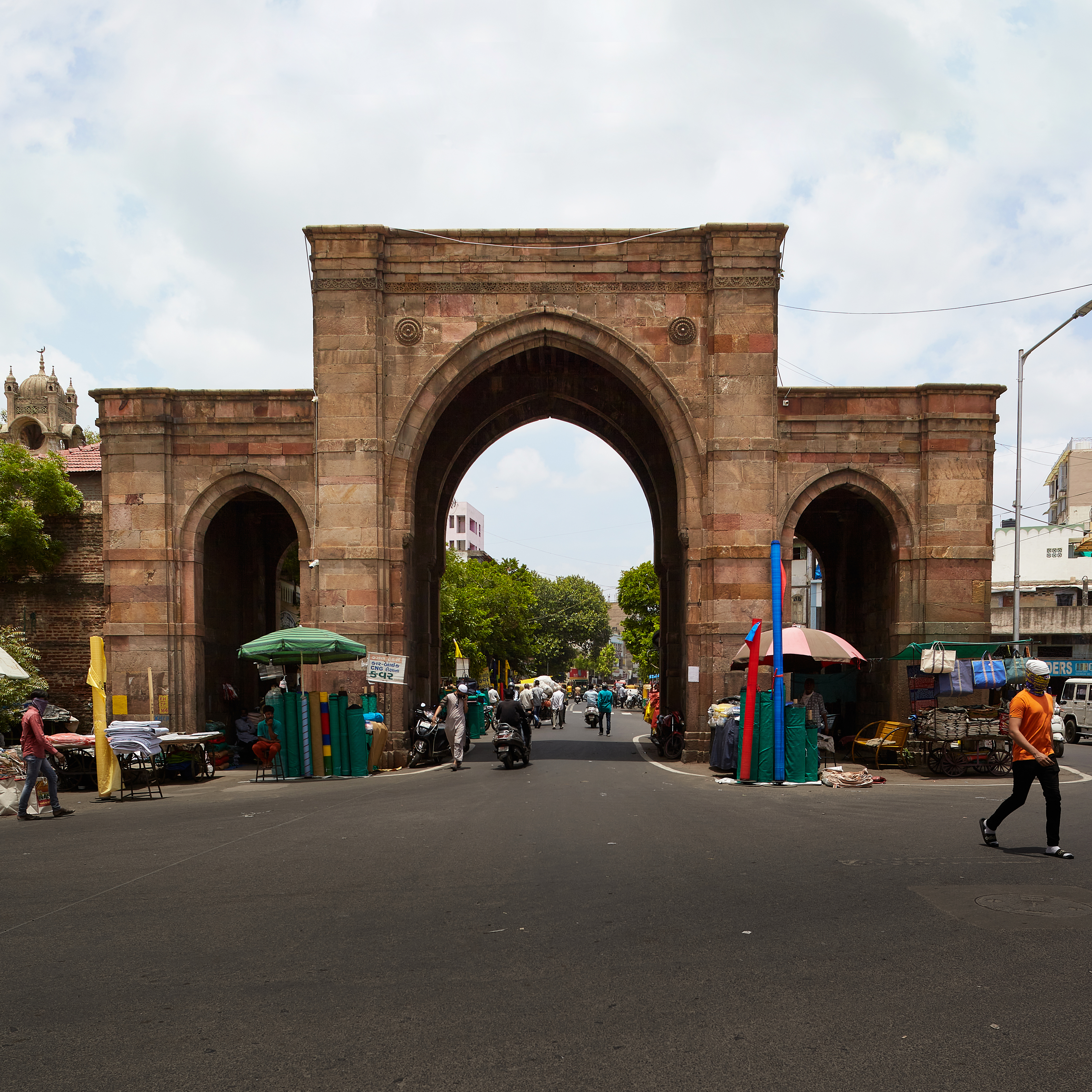
Panchkuva Darwaja
“Panchkuva” literally means Five wells. Of course it’s said that when city grown in size when Britisher’s built “Panchkuva Darwaja” for the purpose of Trade and Transport as well as it has few and before the five wells vanished from the face of area in the name of development. Today the wells location is debatable however it’s still identifiable according to locals and Indologists.
Built in 1871 for easy access to the railway station. Three gateways of pointed arches. This gate was built when the city grew in size. Under the Bombay Presidency Ahmedabad was the hub and district of Northern Division. It was flourishing area with lot of trading income which not only included silk, dals and principal oil seeds but other commodities as well. Being under major commodities. To ease the traffic from Kalupur railway station it was a sudden move approved by then Governor of Bombay Presidency Sir William Robert Seymour Vesey FitzGerald was Anglo Irish Politician and Colonial administrator.
It shouldn’t have forgotten that the site was wasn’t only Britisher’s having that commercial interest before Panchkuva Darwaja was built, but about 150 years back having Amritavarshini Vav, also known as Panchkuva Stepwell or Katkhuni Vav, is a stepwell near the Panchkuva Darwaja. Amritavarshini Vav was completed in 1723 as per Devanagari and Persian inscription (Vikram Samvat 1779/A.H. 1135) in the stepwell. It was built by Raghunathdas, Diwan to Haidar Quli Khan, who was the governor of Gujarat during his stay in the city in 1721–1722 for charitable purpose almost 150 years before Britisher’s saw an opportunity to construct the Darwaja. Panchkuva those days were lodging more than 2000 People including Kadiya, Kumbhar, Stone Masonries, Timber dealer, Carpenters being lodged, being feeded and yes most important this all lodges or Bechraji Mata’s Temple who was feeding to beggars too.
Raghunathdas, diwan of Gujarat to Haidar Quli Khan and his charitable activities included many Sarai’s and small lodges was home to castile accommodations for skilled labors and wealthy traders. Which later redeveloped during industrialization.
Panchkuva as mentioned earlier or Amritavarshini Vav this location was one of the major example of communal harmony. The locals especially senior citizens have mentioned during our field interview that people use to stay here with great harmony, it is believed that Muslim women should practice Hijab (means covering themselves leaving only eyes open were often helped by non-Muslim ladies to help them bringing water from the well and step well. It was kind of a daily ritual that kept Ahmedabad’s cosmopolitan spirit always high.
During my interview Yusuf Bhai aged 68, a tarpaulin shop keeper just next to Darwaja remembers his young days when he witnessed all five wells and his friend Raja Kaka who passed away recently playing together.
Three gateways of pointed arches, the central one 18 feet wide and 28 feet high; and each side gateway 7 feet wide and 19 high.
At a cost of £1115 (INR 11,450), built in 1871 for easy access to the railway station.
Sparsely ornamented, Amritavarshini Vav is notable for its L-shaped plan and has simple design. It has three stories and is more than 50 feet deep. The bracing arches have different shapes at the two storeys and in the Kuta (pavilion tower) before the well shaft. The shafts are beautifully carved adjutants court wall.
Katkhuni Vav is undoubtedly the living heritage. L shaped patterns the Vav followers is rarely seen among Gujarat’s water legacy.
Notes For Visitor:
-Amritavarshini Vav is just next to Darwaja.
-If you wish to see the City area divided in routes climb up small stairs will lead you to rooftop of the Darwaja for bird’s eye view.
-Largest Cycle market is good buy for healthy cyclist as Panchkuva has biggest wholesale market in Gujarat for it.
-Tarpaulins and Tarpaulins Bags or in roll canvas shops are also there and again they house biggest wholesale market as well.
MOST POPULAR ATTRACTION
Katkhuni Vav is undoubtedly the living heritage. L shaped patterns the Vav followers is rarely seen among Gujarat’s water legacy.
NEARBY SITES
Mughal era, Historic Monuments, Pols & Living Heritage, Sites With Audio Guides, Sites with Bluetooth Beacons
Pols & Living Heritage, Havelis & Private Residences, Sites with QR Codes
Havelis & Private Residences, Sites with QR Codes
Spiritually Significant, Religious sites - Hinduism, Sites With Videos
Havelis & Private Residences, Sites with QR Codes
Ahmedabad’s Popular, Sultanate era, Sites With Audio Guides, Sites with Bluetooth Beacons
Spiritually Significant, Religious sites - Hinduism, Sites With Virtual Tours, Sites With Audio Guides
Independence era, Industrial History, Museums and Institutes, Sites with QR Codes
NEARBY AMENITIES


APPROXIMATE TIME REQUIRED TO VISIT
10 Minutes
THINGS TO KNOW
The historic darwajas of Ahmedabad stand proudly upright, marking the boundaries of the old walled city of Ahmedabad. Being part of the public infrastructure of the city, they are open to visitor during all hours of the day. However, it is best to visit during day time to properly appreciate the architectural details and also enjoy the thriving markets in and around them.
Timings :Any Time
Entry Fee : Free








